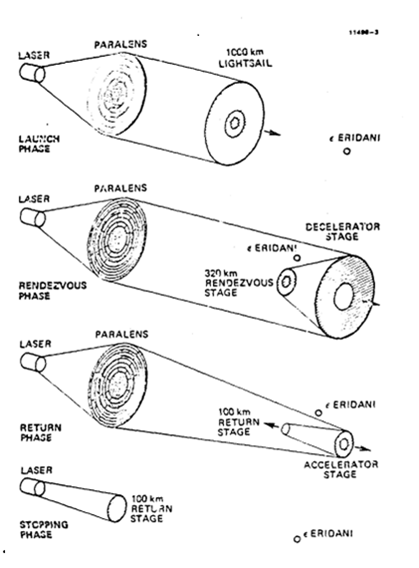Impractical as they would be dead long before such a craft could be made.
Now... If they wanted to take a ride in this Red Tesla Roadster...
/cdn.vox-cdn.com/uploads/chorus_image/image/58088359/Screen_Shot_2017_12_22_at_2.22.54_PM.0.png)
Posted on 12/27/2017 3:54:49 PM PST by Simon Green
If you thought NASA was playing the long game with its plan to put people on Mars in the 2030s, you haven't seen anything yet. New Scientist has learned that a team at the administration's Jet Propulsion Laboratory has started planning a mission that would send a spacecraft to the Alpha Centauri system in... 2069. Yes, that's 52 years away, and timed around the 100th anniversary of Apollo 11's trip to the Moon. The probe would look for signs of life around the potentially habitable exoplanet Proxima b, giving humanity a much better look than it could get with observation from home.
So why the long wait? Simple: the technology to make this trip realistic doesn't exist yet. The JPL is counting on propulsion technology advancing to the point where the results would come back in time to be meaningful. When Alpha Centauri is nearly 4.4 light-years away, a ship traveling at a tenth the speed of light would take 44 years to arrive. As such, it's doubtful that you or even the next couple generations of your family would live to see the results. The probe wouldn't reach the system until around 2113, and of course the data wouldn't get back to Earth until 4.4 years later at best.
Nonetheless, it's notable that NASA even has a mission like this on its radar, assuming budget cuts and other decisions get in the way. It's starting to think about its role in the very long term, when interstellar exploration won't just be limited to telescopes. And if the time frame gets you down, take heart. Breakthrough Starshot is hoping to launch a small probe that would both depart much sooner and travel much faster, arriving as quickly as 20 years. Think of NASA's 2069 mission as a backup if Starshot doesn't work, or a follow-up that could study the star system in greater depth.
What? NASA wants funding guaranteed through 2069?
OPM. It is very easy to use other people’s money to fund such things.
OPM. It is very easy to use other people’s money to fund such things.
Occam’s Razor Answer: It’s an excuse for NASA to submit 51 years worth of budget proposals.
No I am sure I am correct as I recently watched all the starting episodes.
Speaking of that, let's say you launch a craft and have it accelerate to the speed of light which you achieve at the halfway point.
Now... you would immediately have to start slowing down back to a reasonable speed so that you could have a chance at orbiting any planet you were trying to get to. No matter how far, no matter how fast you go, halfway there you have to start slowing down.
This would limit how 'fast' we could get to a planet of another star. AND.... how would you slow down ?
Wow. I'm on Season 2 Episode 10. It takes me a while to watch an episode because my brain threatens to remove itself from my body if I watch too long.
Season 1 was all about the 'getting lost' and Dr. Smith was about a good example of a modern day liberal as you can get.
Season 2 (and I'm sure 3 as well) were all about giving out of work actors a job. They would pick a costume and notify the writing staff, who when then concoct a storyline to fit the costume. The props were mostly recycled crap from other movies and TV shows.
The show was really just an attempt to extend the Batman Series popularity and adopt to the new interest in Science Fiction.
Just watch the end of each episode....
Same (BAT) Time,,,, Same (BAT) Channel.
It was all about 'camp' and comedy and 'disaster'. Irwin Allen was the MASTER OF DISASTER.
Impractical as they would be dead long before such a craft could be made.
Now... If they wanted to take a ride in this Red Tesla Roadster...
/cdn.vox-cdn.com/uploads/chorus_image/image/58088359/Screen_Shot_2017_12_22_at_2.22.54_PM.0.png)
I would say that is an understatement.
Once it got to where it was going, how did it 'slow down' ?

The same lasers can be used to decelerate the spacesship as well.

Forward’s separable sail concept used for deceleration, from his paper “Roundtrip Interstellar Travel Using Laser-Pushed Lightsails,” Journal of Spacecraft and Rockets 21 (1984), pp. 187-195. The ‘paralens’ in the image is a huge Fresnel lens made of concentric rings of lightweight, transparent material, with free space between the rings and spars to hold the vast structure together, all of this located between the orbits of Saturn and Uranus.
So granted, this concept requires that we have the capability of constructing a thousand mile wide structure in deep space.
But that's just a minor engineering issue. The math works, it seems. :-)
Probably the only part of it that does or ever will work.
Using the concept you cited, how long would it take the ‘craft’ to slow back down to where it could orbit a planet (assuming that it accelerated to a speed fast enough to get the passengers to Eridani within their lifetime) ?
As I recall (it's been a long time since I read it) they boost for a couple of years, coast at 0.2C for about 35 years, then decelerate for a couple of years.
They also take a drug which slows their aging process, whilst proportionately lowering their effective I.Q., but allowing them to arrive only a decade physically older than when they left,
Disclaimer: Opinions posted on Free Republic are those of the individual posters and do not necessarily represent the opinion of Free Republic or its management. All materials posted herein are protected by copyright law and the exemption for fair use of copyrighted works.